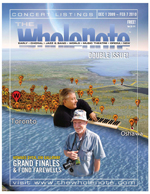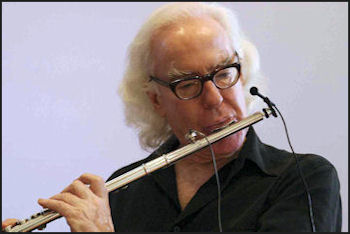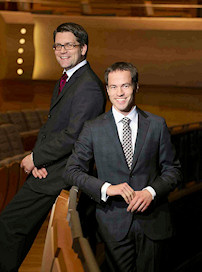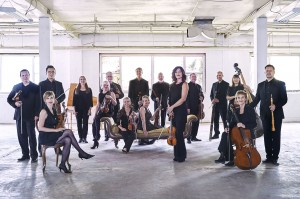“Make new friends, but keep the old.
One is silver and the other gold”
So go the words of a song more than a few of you will know, and might even have sung, as a canon, perhaps – silvery threads of melody weaving their magic in the flickering gold of a campfire’s light, round and round. “Make new …. make new …. make…new…”, “gold ... gold ... gold.” In such moments of collective creation and re-creation is a lifelong love of music born.
“Bumps” is the word that editor Colin Eatock chooses in this month’s Opener, on page 6, to describe the process of gently nudging you, esteemed reader, toward events we’d like you to notice. “Ten bumps” is his ambitious title, and indeed he delivers ten – spread judiciously throughout the upcoming season.
So what the heck. Here’s my two cents worth on the bumpy theme: ladies and gentlemen, direct your attention, if you will, to Row J, seat 11, Jane Mallett Theatre, St. Lawrence Centre, April 8, 2010, at, let’s say, 9.15pm. That’s me sitting there, perhaps reading the always interesting programme notes, but mostly just waiting for the single work in the second half of the evening’s concert to start.
For the audience at the evening’s Music Toronto concert, the featured performers are indeed old friends. The Tokyo String Quartet has been coming to Music Toronto almost every year since 1974 (albeit with some changes in personnel). Even for subscribers who haven’t been around that long, there’s a heightened sense of connection with the ensemble, because this is the fourth concert of six, over a three year period, encompassing the entire Beethoven string quartet cycle.
So, April 8, 2010 at 9.15, in seat J11, I will sit awaiting the moment when the disquieting opening notes of Beethoven’s ninth string quartet (the Quartet in C Major, Op. 59, No.3 ‑the last of the three named Rasumovsky) start to spread like smoky gold into the attentive air.
That moment, when it arrives, will be a “bump” of a different kind for me – the kind that I’m told time-travellers experience, touching down. You see, on April 10 2010, it will be exactly 33 years and 333 days since the start of the most significant two weeks of my musical life. And on the final night of that two weeks (May 10-21 1976) I sat, same hall, roughly same spot, while another eminent string quartet, alas long silenced, wrapped the tendrils of those same uncompromising chords around my much younger heart.
It wasn’t called the Jane Mallett Theatre in those days, it was the Town Hall. And the series was not called Music Toronto, it was called Music at the Centre. It was the year of the Montreal Olympics, so the Amadeus String Quartet’s six-concert-in-two-weeks performance of the entire 17 quartet cycle was predictably described in Olympian terms. And the cycle was performed not in the order Beethoven wrote the quartets (which is what the Tokyo is doing) but in a mesmerizing mixture of early, middle and late quartets in each programme. And this work, the third Rasumovsky, was, as I mentioned, the very final work in the final concert of the two weeks.
If you’d asked me, I’d have argued till the cows came home for the final opus of the cycle to be one of the late quartets – probably the Grosse Fugue. I had loved some Beethoven from my teens, especially the Emperor, and the Waldstein Sonata. But barely a year before this time, in my early twenties, I had been introduced to his late quartets, and my sense of music’s power – to express the inexpressible – had been changed forever.
So my assumption back in 1976, I suppose, would have been that the older Beethoven would have been as dismissive of his younger self as I then was. The third Rasumovsky, May 21, 1976, changed that for me. From its smoky opening to the unfussy simplicity of its close, it was all-encompassing, early and late, old and new.
I was new to town. But since that day, that concert series in that hall has stood for me as a hallmark of chamber music as it should be experienced – the right size hall for the audience’s attentiveness to be a palpable part of things, and above all, as the years roll by, a sense of curatorial connectedness, of continuity and change.
Now I am sitting looking at the Music Toronto (“Music at the Centre”) season brochure for 1981 – their tenth anniversary season: listed under piano recitals we have Anton Kuerti, Arthur Ozolins, Andras Schiff, Alfred Brendel, Jean-Philippe Collard , Emanuel Ax. “Aha,” you say, “in those days they could afford to bring in the truly greats.” But if you say so, you are missing a fundamental point. To give but one example: Andras Schiff, in this brochure’s words is “the young Hungarian virtuoso.” And the Sunday “Introductions” series that year asks audiences to take a chance on such unknowns (to us anyway)as Peter Oundjian, Norbert Kraft and Bonnie Silver, and Catherine Robbin.
New friends and old, a lobby where people recognize, nod and greet, a sense of history, continuity and adventure, for presenter, artists, and audience alike – these are the things that a chamber series with a pedigree, in a truly chamber-sized venue, continues to offer.
Like everyone around here, I’m getting a bit giddy as excitement over the new Koerner Hall mounts.
So, welcome, new friend. But, on that night I have a date with someone I’ve known a long time.

David Perlman, publisher
 Those of you whose curiosity was piqued by our December wrap-around cover with its little forest of pins will I hope be equally intrigued by the invitation (at the foot of page 62 in this month’s magazine) to visit our website and take a look at our “world of The Whole-Note” website map.
Those of you whose curiosity was piqued by our December wrap-around cover with its little forest of pins will I hope be equally intrigued by the invitation (at the foot of page 62 in this month’s magazine) to visit our website and take a look at our “world of The Whole-Note” website map.





